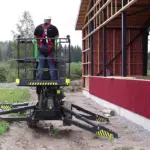Deep within an overgrown forest near what was once the Eastern Front of World War II, an extraordinary discovery has emerged from the shadows of history. Nestled high between the branches of two gnarled trees, a rusted WWII-era sniper rifle was recently uncovered—seemingly untouched since the day it was left behind, likely in 1943. Its position, propped purposefully for observation, is both haunting and awe-inspiring. Time has eaten away at the wood and metal, but the story it tells remains vivid and chilling.

A Frozen Moment from a Forgotten War
The rifle—its wooden stock split and brittle, its scope clouded and frame coated in a stubborn patina of rust—has withstood over 80 years of bitter winters, humid summers, and forest decay. Experts believe it belonged to a Soviet or German sniper stationed in the area during some of the fiercest fighting of the war’s Eastern campaigns. That the weapon was still balanced in its original position is not just improbable—it borders on the miraculous.
This was not a haphazard discard. Its placement between the branches, aimed toward a clearing now reclaimed by foliage, suggests it was part of a carefully prepared sniper’s nest. Snipers in WWII were not just killers; they were sentinels. Their duties ranged from eliminating high-value targets to providing quiet reconnaissance, often remaining motionless in one location for hours, even days.
The Silence After the Storm
The area where the rifle was found once echoed with the sounds of war—gunfire, tank engines, shouted orders, and the desperate cries of the wounded. Now, it is eerily still. That stillness is perhaps the most haunting aspect of the rifle’s survival: the idea that its last user never returned to retrieve it. There is no indication of a struggle in the immediate vicinity—no shell casings, no torn uniform fragments. Only the rusted metal, like a gravestone without a name.
Speculation abounds. Was the sniper killed in action, leaving the rifle behind in a panicked retreat? Did he succumb silently in the brush to wounds or exposure? Or was the rifle part of a decoy nest, set up to mislead advancing troops and abandoned intentionally? Each theory adds another layer to the weapon’s mystery, enriching its eerie allure.
A Testament to a Vanished War
Discoveries like this are rare but not unheard of. The dense forests and remote battlefields of Eastern Europe still yield relics from time to time—helmets, medals, rusted vehicles, even human remains. But the condition and positioning of this rifle set it apart. Unlike museum pieces kept polished behind glass, this weapon remained part of the forest for decades. Moss crept over its barrel. Branches grew around it. It became part of the woods, part of nature’s slow, quiet reclaiming of what war once stole.
For historians, the rifle is more than a weapon—it’s a lens. It offers a raw, uncurated view into the day-to-day tension of sniper warfare. These soldiers operated in near-total isolation, often with only their rifle and instincts as company. Their work demanded inhuman patience and nerves of steel, all while knowing a single glint of sunlight on glass could give away their position—and end their life in an instant.
Preserving the Legacy
The rifle has since been carefully removed for conservation and study, though some argue it should have been left untouched, a ghostly monument in the forest. Conservators are analyzing the weapon’s markings to determine its exact origin—whether it was a Soviet Mosin-Nagant PU or a German Karabiner 98k with a ZF39 scope. Initial assessments lean toward Soviet manufacture, but corrosion obscures definitive identification.
Regardless of its make, the weapon’s symbolism is universal. It’s a stark reminder of the young men—marksmen on both sides—who endured the harshest conditions not for glory, but for survival. Most will remain nameless, buried beneath unmarked soil or simply vanished into the mists of time.
Like Us on Facebook!
Conclusion: A Story in Stillness
In an era saturated with digital reconstructions and blockbuster portrayals of war, this silent rifle speaks volumes through its simplicity. It doesn’t dramatize. It doesn’t shout. It simply exists, as it has for 80 years—weather-worn and waiting. It is both a relic and a requiem, a steel testament to the frozen intensity of conflict and the haunting quiet that followed.
Subscribe Us on YouTube!
As it lies under expert care, its story will now be told, its presence honored. Because sometimes, the loudest echoes from war come not from gunfire—but from what’s left behind.

















